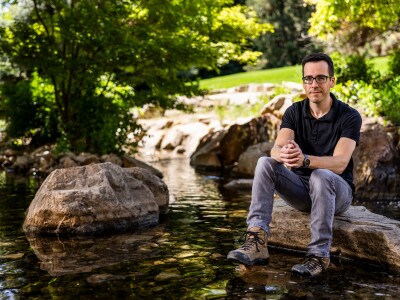In Tuesday’s campus forum, aerospace engineer and planetary scientist Alan Stern discussed the NASA mission to Pluto, New Horizons, and how his team was able to accomplish the impossible through commitment and collaboration.
Before New Horizons, the only photos that existed of Pluto were pixelated, blurry and hard to decipher. Even using the best tools, such as the Hubble Telescope, there was a limit on the amount that could be learned about the planet on the edge of the solar system.
Stern and his small team of creators thought, what if we can talk NASA into making this happen? Can we go to Pluto?
“It turned out, we could.” Stern said. “It took a long 26 years. There was not a clear path. And none of us knew how to pull it off. But because we were committed, every time we hit a setback, we dusted ourselves off and started again and again and again.”

When Stern was a kid, all he wanted to do was explore space. It was his passion, driving him to get multiple master’s degrees and a doctorate that eventually led him to NASA. After being involved in dozens of planetary space missions, serving on various committees and serving as an associate administrator, Stern became the director for the New Horizons mission to Pluto, what is now one of the most celebrated projects in history.
“Pluto is a scientific bonanza,” Stern said. “We were successful in a really complex project. Every time I say that, it sounds like science fiction, but it’s not. We launched a spacecraft and flew it all the way across the solar system.”
And they did it in record-breaking time. While other projects had at least nine years to build and launch a spacecraft of this size and complication, the New Horizons team had four. If they had waited any longer, the window of opportunity wouldn’t arise until the middle of the next decade.
Stern compared the monster of a task ahead of his team to launching a golf ball from LA to a hole in New York City and expecting to achieve a hole-in-one in a single shot.
“I can’t tell you how many times I thought, ‘We are doomed. We’ve run out of ideas. We are exhausted,’” Stern said. “I was told by multiple people at NASA that this was not good for my career. But we were committed. We thought this was the chance to be a part of something legendary, the stuff of dreams.”
Achieving such a feat took over 2500 people putting in nights, weekends and overtime for over 20 years.
“If you put the right team together and you break down the barriers and trust one another, a team can achieve things that are larger than life,” Stern said.
Stern concluded by showing a photo of Pluto backlit by the sun, commenting that it’s his favorite picture from the mission.

“The reason I like this picture so much is that there’s only one way to get a picture like this: You had to have accomplished the project,” Stern said. “After 26 long years, this says, ‘That team of people did it, and they did it spectacularly.’”
Next Devotional: Bonnie H. Cordon, Young Women General President
Sister Bonnie H. Cordon, Young Women General President of The Church of Jesus Christ of Latter-day Saints, will deliver the BYU Devotional on Tuesday, February 4, at 11:05 a.m. in the Marriott Center.
Her remarks will also be broadcast live on BYUtv, BYUtv.org (and archived for on-demand streaming), KBYU-TV 11, Classical 89 FM, BYU Radio and will be archived on speeches.byu.edu.



